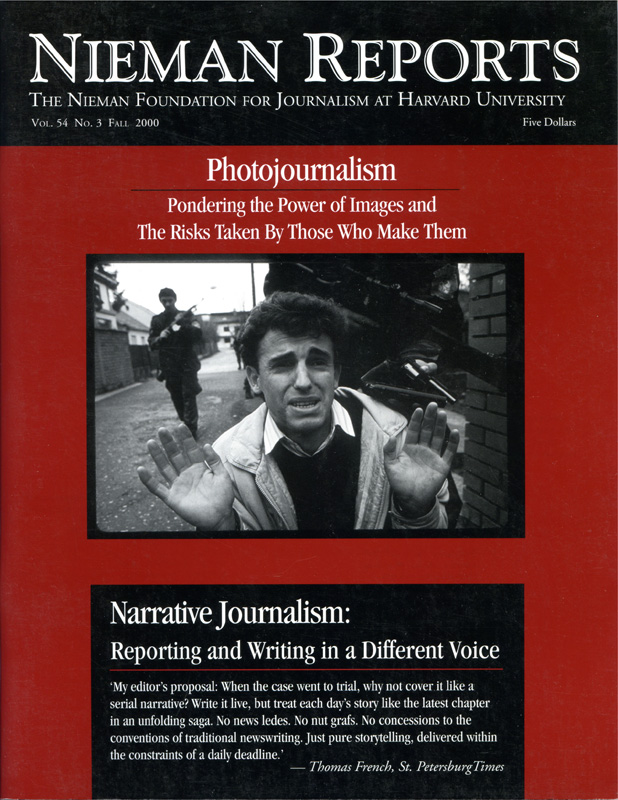Mark Kramer, who directs a narrative journalism conference each year at Boston University, opens our series of articles by asserting that “narrative writing is returning to newspapers.” The reasons are as simple as the lure of storytelling and as complex as the business environment in which newspapers struggle to survive. In this issue, newspaper writers and editors, television correspondents and anchors, journalism professors and physicians write about narrative’s revival in the telling of news. Their words speak of possibilities, but also warn of the need for caution.
New York Times editor Gerald Boyd (’81 NF) writes that the Times, in its 15-part series designed to tell the story of how race is lived in America, deliberately chose a narrative presentation: “We thought race was far too complicated to handle any other way.” Roy Peter Clark, who teaches writing at the Poynter Institute, hopes the divide will narrow between those who embrace narrative and those who cling to the Five W’s and the H. Thomas French writes about his work in serial narratives at the St. Petersburg Times in which a news story develops drama and character more familiar to books.
Formerly a St. Louis Post-Dispatch editor, now Stanford journalism professor, William Woo (’67 NF) worries that narrative writing—which by its nature subordinates ideas to drama and conflict and requires superimposing a storytelling order on facts—might steer journalists away from their job to “just write what happened.” A panel of journalists, moderated by Atlantic Monthly senior editor Robert Vare (’97 NF), addresses such concerns. Then The Oregonian’s Richard Read (’97 NF), who won a Pulitzer Prize for his narrative series “The French Fry Connection,” describes why narrative journalism is not as easy to execute as it might seem. Philadelphia Inquirer reporter Mark Bowden traces the journey of his narrative series “Black Hawk Down” from the newspaper onto the Internet, where even more avenues for storytelling were found. Rick Bragg (’93 NF), The New York Times’s Miami bureau chief, contends that narrative can be “the most effective way to tell even a hard news story,” and he shares examples from his coverage of the Oklahoma City bombing. Anthony DeCurtis, contributing editor at Rolling Stone, looks through the lens of celebrity journalism and worries that invention might be replacing interpretation.
The use of narrative in television news has its own rationale and methods. Ted Koppel explains why he uses the approach of a storyteller to entice viewers to stay tuned. ABC News correspondent Robert Krulwich describes how he tries to get his stories to stick in peoples’ minds. Atlantic Monthly Editor in Chief Michael Kelly laments that the camera has usurped the writer’s descriptive mission. And Carolyn Mungo, a local TV reporter in Houston, shows how narrative can still find a home on the six o’clock news.
Writing a book reminded Washington Post writer Laura Sessions Stepp of the value of connecting narrative with analysis and information. University of Massachusetts professor Madeleine Blais (’86 NF) introduces her students to narrative nonfiction books to prepare them as journalists. And Fitzhugh Mullan, a physician and writer, infuses a health policy journal with narrative writing.
New York Times editor Gerald Boyd (’81 NF) writes that the Times, in its 15-part series designed to tell the story of how race is lived in America, deliberately chose a narrative presentation: “We thought race was far too complicated to handle any other way.” Roy Peter Clark, who teaches writing at the Poynter Institute, hopes the divide will narrow between those who embrace narrative and those who cling to the Five W’s and the H. Thomas French writes about his work in serial narratives at the St. Petersburg Times in which a news story develops drama and character more familiar to books.
Formerly a St. Louis Post-Dispatch editor, now Stanford journalism professor, William Woo (’67 NF) worries that narrative writing—which by its nature subordinates ideas to drama and conflict and requires superimposing a storytelling order on facts—might steer journalists away from their job to “just write what happened.” A panel of journalists, moderated by Atlantic Monthly senior editor Robert Vare (’97 NF), addresses such concerns. Then The Oregonian’s Richard Read (’97 NF), who won a Pulitzer Prize for his narrative series “The French Fry Connection,” describes why narrative journalism is not as easy to execute as it might seem. Philadelphia Inquirer reporter Mark Bowden traces the journey of his narrative series “Black Hawk Down” from the newspaper onto the Internet, where even more avenues for storytelling were found. Rick Bragg (’93 NF), The New York Times’s Miami bureau chief, contends that narrative can be “the most effective way to tell even a hard news story,” and he shares examples from his coverage of the Oklahoma City bombing. Anthony DeCurtis, contributing editor at Rolling Stone, looks through the lens of celebrity journalism and worries that invention might be replacing interpretation.
The use of narrative in television news has its own rationale and methods. Ted Koppel explains why he uses the approach of a storyteller to entice viewers to stay tuned. ABC News correspondent Robert Krulwich describes how he tries to get his stories to stick in peoples’ minds. Atlantic Monthly Editor in Chief Michael Kelly laments that the camera has usurped the writer’s descriptive mission. And Carolyn Mungo, a local TV reporter in Houston, shows how narrative can still find a home on the six o’clock news.
Writing a book reminded Washington Post writer Laura Sessions Stepp of the value of connecting narrative with analysis and information. University of Massachusetts professor Madeleine Blais (’86 NF) introduces her students to narrative nonfiction books to prepare them as journalists. And Fitzhugh Mullan, a physician and writer, infuses a health policy journal with narrative writing.



